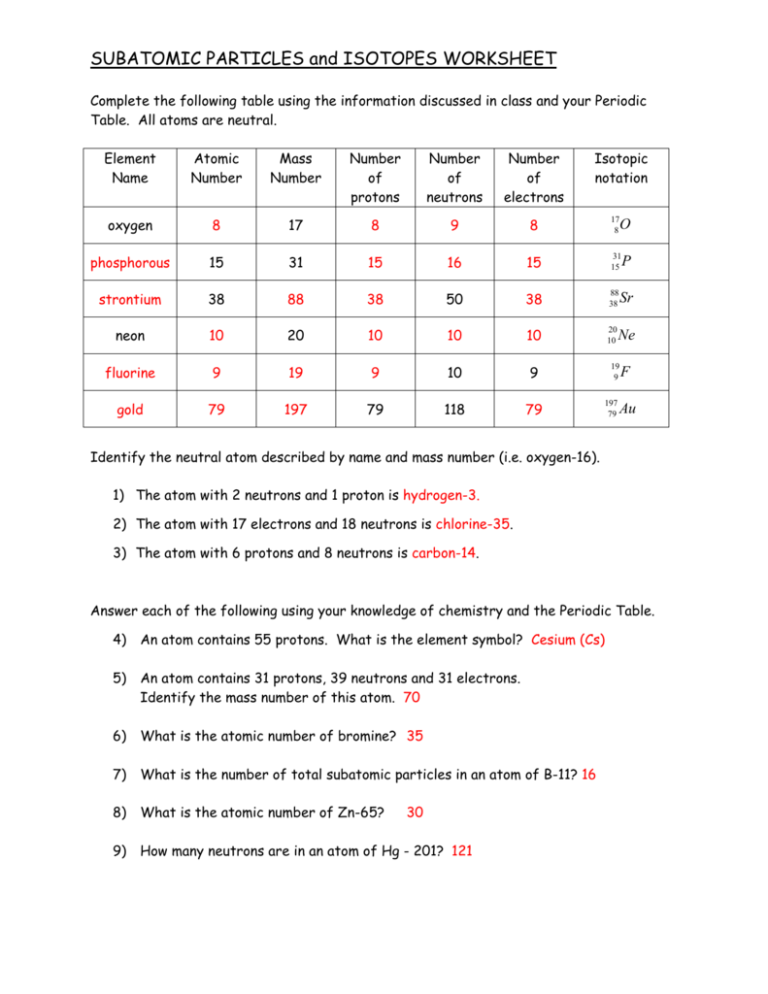SUBATOMIC PARTICLES and ISOTOPES WORKSHEET
advertisement

SUBATOMIC PARTICLES and ISOTOPES WORKSHEET Complete the following table using the information discussed in class and your Periodic Table. All atoms are neutral. Isotopic notation Element Name Atomic Number Mass Number Number of protons Number of neutrons Number of electrons oxygen 8 17 8 9 8 17 8 phosphorous 15 31 15 16 15 31 15 strontium 38 88 38 50 38 88 38 neon 10 20 10 10 10 20 10 fluorine 9 19 9 10 9 gold 79 197 79 118 79 P Sr Ne 19 9 197 79 O F Au Identify the neutral atom described by name and mass number (i.e. oxygen-16). 1) The atom with 2 neutrons and 1 proton is hydrogen-3. 2) The atom with 17 electrons and 18 neutrons is chlorine-35. 3) The atom with 6 protons and 8 neutrons is carbon-14. Answer each of the following using your knowledge of chemistry and the Periodic Table. 4) An atom contains 55 protons. What is the element symbol? Cesium (Cs) 5) An atom contains 31 protons, 39 neutrons and 31 electrons. Identify the mass number of this atom. 70 6) What is the atomic number of bromine? 35 7) What is the number of total subatomic particles in an atom of B-11? 16 8) What is the atomic number of Zn-65? 9) How many neutrons are in an atom of Hg - 201? 121 30 10) All atoms of the same element must contain the same number of (A) protons (C) electrons plus protons (B) neutrons (D) protons plus neutrons 11) What is the total number of protons in a nucleus of magnesium-23? (A) 23 (B) 11 (C) 12 (D) 16 12) Isotopes of a given element contain (A) Same number of neutrons but different number of protons (B) Same number of neutrons and protons (C) Same number of protons but a different number of neutrons (D) Same number of protons but a different number of electrons 13) An atom with 29 protons and 36 neutrons is an isotope of (A) Si (B) Cu (C) Kr (D) Cl 14) Carbon exists as three naturally occurring isotopes: C-12, C-13 and C-14. As the number of neutrons increase in the isotope, the nuclear charge (A) increases (B) decreases (C) remains the same 15) An atom of an element is electrically neutral because the (A) Number of protons equals the number of electrons (B) Number of protons equals the number of neutrons (C) Number of neutrons equals the number of electrons 16) What is the nuclear charge of an atom of nitrogen-14? (A) +14 (B) +7 (C) 0 (D) +6 17) Calculate the average atomic mass of chromium, given the following percent abundances and isotope masses: 4.350 % 49.946 amu; 83.790% 51.941 amu; 9.500% 52.941 amu and 2.360% 53.939 amu (49.946amu )( 2.172651 4.350 83.790 9.500 2.360 ) + (51.941amu )( ) + (52.941amu )( ) + (53.939amu )( ) 100 100 100 100 + 43.521363 + 5.029395 + 1.2729604 = 51.996369 amu Subatomic Particles Worksheet






